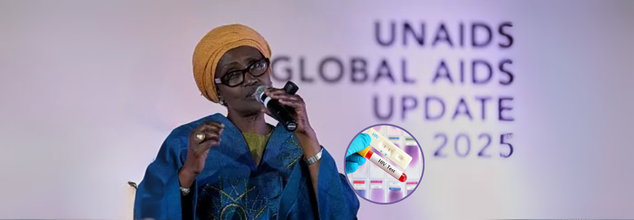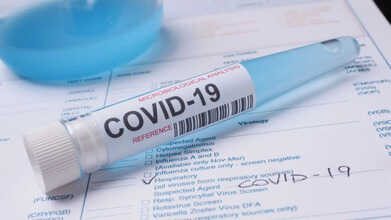- Health Conditions A-Z
- Health & Wellness
- Nutrition
- Fitness
- Health News
- Ayurveda
- Videos
- Medicine A-Z
- Parenting
- Web Stories
UN Warns Millions Could Die By 2029 If US Cuts HIV Funding

Credits: AP
For two decades, American-led investment through programs like PEPFAR (The U.S. President’s Emergency Plan for AIDS Relief) has helped slash global AIDS-related deaths to their lowest levels in over 30 years. But this progress is now at serious risk. A sudden and sweeping withdrawal of U.S. foreign aid has triggered what the United Nations is calling a “systemic shock” to HIV response systems around the world.
According to a new UNAIDS report, if the funding gap remains unresolved, the world could see more than 4 million additional AIDS-related deaths and 6 million new HIV infections by 2029. The consequences are already visible — health facilities shuttered, supply chains broken, testing and treatment disrupted, and clinics in sub-Saharan Africa forced to halt vital HIV services.
In January, President Trump abruptly suspended all foreign aid and took steps to dismantle the U.S. Agency for International Development (USAID). That move wiped out $4 billion in pledged HIV funding for 2025, including the backbone funding for programs in Africa, Asia, and Latin America.
Launched in 2003 under President George W. Bush, PEPFAR has been called the largest commitment by any country to fight a single disease. Since its inception, it has supported HIV testing for more than 84 million people and treatment for over 20 million. Countries like Nigeria, where 99.9% of the national HIV prevention budget was supported by PEPFAR, are now facing catastrophic disruption.
Andrew Hill, an HIV researcher at the University of Liverpool, criticized the U.S. government's abrupt move: “Any responsible government would have given advance warning so countries could plan,” he said. “Instead, patients were stranded, and clinics closed overnight.”
The Domino Effect
The fallout from the funding cut is widespread. UNAIDS has reported large-scale impacts: medical facilities without staff, vital medications running out, and HIV testing and surveillance collapsing in several regions.
The U.S. was the main funder of HIV data systems across Africa — from patient records to electronic surveillance systems. With that infrastructure now unsupported, global experts worry that tracking and controlling the spread of HIV is about to get significantly harder.
“Without reliable data about how HIV is spreading, it will be incredibly hard to stop it,” said Dr. Chris Beyrer, director of the Global Health Institute at Duke University.
What makes this funding crisis even more tragic is the timing. Just as the world reaches the brink of a possible HIV breakthrough, it may be losing the means to distribute it.
Gilead’s new injectable drug, Yeztugo, was approved by the U.S. FDA last month. Clinical trials suggest it is 100% effective at preventing HIV when administered twice a year. At a launch event, South Africa’s Health Minister, Dr. Aaron Motsoaledi, emphasized its potential: “We will move mountains and rivers to make sure every adolescent girl who needs it will get it.”
Yet many countries may never see the drug. Gilead has promised low-cost generic versions for 120 poorer countries, but has notably excluded most of Latin America — where HIV rates are increasing, even if they are lower overall.
Peter Maybarduk, director at Public Citizen, called it a “threshold moment” in the fight against AIDS. But he fears it will be squandered: “We could be ending AIDS. Instead, the U.S. is abandoning the fight.”
Sub-Saharan Africa accounts for roughly half of all new HIV infections globally. Even before the U.S. pullback, access to care and medication in the region was fragile and uneven.
Dr. Tom Ellman, with Doctors Without Borders in South Africa, put it bluntly: “There’s nothing we can do that will protect these countries from the sudden, vicious withdrawal of support from the U.S.”
While some nations have begun building domestic HIV response programs, the gap left by the U.S. is simply too wide. Prevention campaigns are faltering, awareness efforts have stalled, and many community-based initiatives have been forced to shut down or drastically scale back.
In 2004, AIDS claimed nearly 2 million lives globally. By 2024, that number had dropped to around 630,000, largely thanks to international funding and collaborative programs. But UNAIDS warns that without renewed support, these hard-won gains could unravel rapidly.
Geopolitical shifts, ongoing wars, and climate-related disruptions are already putting pressure on global health cooperation. The loss of the U.S. as a stabilizing force in the HIV response leaves many questioning what’s next.
The most vulnerable — young women, children, LGBTQ+ communities, and those in poverty — stand to lose the most.
UNAIDS and other global health leaders are urging the international community to step up. Whether through restoring U.S. funding or rallying alternative donors, a coordinated response is essential. Experts are also calling for pharmaceutical companies like Gilead to expand access and reduce costs, ensuring that breakthroughs don’t become tools of inequality.
The global AIDS fight is far from over. In fact, this moment may determine whether it's won or lost.
If nothing changes, the consequences are clear: millions of lives in the balance, and a public health crisis reborn from neglect.
Jesse Eisenberg Opens Up About Donating His Kidney to a Stranger; Understanding The Risks And Health Implications

(Credit-Golden Globes)
Jesse Eisenberg has opened up about his intention to donate his kidney to a stranger. He deemed the decision as a “no-brainer.” Known for films like Now You See Me, the 42-year-old actor shared the news on the Today show on October 30th, as he explained that he got the "blood donation bug" after participating in a blood drive over the summer.
Eisenberg stated he is scheduled for an altruistic donation, which is also known as a non-directed living donation, in mid-December. This means he is donating his organ to someone he does not know, with the recipient being selected based on medical compatibility.
Eisenberg stands by his decision, emphasizing, “It's essentially risk-free and so needed." He believes more people will realize "it's a no-brainer, if you have the time and the inclination.”
His reason for saying that donating his kidney is a ‘risk free’ decision is that, after this procedure, through the National Kidney Foundation's family voucher program, his family would be prioritized should if any of them ever need a living kidney donation in the future.
Donating a kidney can help improve the quality of life and survival for the receiver, however there are a few health implications one should keep in mind.
What Happens When You Do A Living Kidney Donation?
The American Kidney Fund explains that a living donation is a kidney transplant where a person who is alive and healthy gives one of their two healthy kidneys to a person with serious kidney disease. Kidneys that come from a living person usually work better and last longer than those that come from someone who has died. There are 2 types of kidney donations:
Non-directed Donation (Altruistic Donation)
This is when the person donating the kidney does not pick the recipient. Instead, they donate the kidney to a stranger. This is often done through a program that helps swap kidneys between people (a paired kidney exchange). Jesse Eisenberg is opting for this method.
Directed Donation
This is when the person donating the kidney chooses the specific person who will receive it, for example, a family member or a close friend.
Who Can Donate A Kidney, Are There Any Benefits?
To be able to donate a kidney while you are alive, you must meet a few requirements:
- You must be 18 years old or older.
- You must have two healthy, working kidneys.
- You must be healthy enough to handle the surgery and recovery.
Most people who donate a kidney can get back to their normal life in about two to four weeks. However, a team of doctors and nurses carefully checks the donor to make sure they understand all the possible physical, emotional, and financial risks.
- You help the person who receives your kidney to live longer and be healthier, and you may even save their life.
- The detailed check-up you go through helps you learn more about your own health.
What Are The Health Risks of Kidney Donation?
Like any surgery, kidney donation also carries physical risks. These can include common issues like pain at the surgical site, feeling weak and tired, or bloating. More serious, though less frequent, risks involve bleeding and the formation of blood clots, problems related to anesthesia such as pneumonia, a blocked bowel, and the possibility of infection. Additionally, donors will have a scar from the surgery and may feel sick to their stomach afterward.
The American Kidney Fund also explains that there may also be some emotional risks involved. Some people feel anxious, stressed, sad (depressed), or guilty if the kidney they gave doesn't work well for the recipient. It is a very noble task to help someone gain a second chance for a better life. Understanding the risks and health implications can help you make the most informed choice. Let your healthcare professionals know about your doubts and worries, as it will help them make the process better for you.
NHS Warns Long Covid Patients To Avoid This Common Mistake

Credits: Canva
Some people who recover from Covid-19 continue to feel unwell for weeks or even months afterward. This condition, called long Covid or post-Covid syndrome, is diagnosed when symptoms last for more than 12 weeks. If you are experiencing it, doctors say there is one thing you should be cautious about.
Although long Covid is not usually life-threatening, it can cause ongoing discomfort and affect many parts of the body in different ways. According to NHS guidance, symptoms vary from person to person and can shift over time.
While the condition can be difficult to manage, there are several treatment options available. These may include physiotherapy, cognitive behavioural therapy, and nutritional guidance to ease symptoms and improve overall health. If you think you might have long Covid, it’s best to see your GP. They can assess your symptoms, run a few tests, and help you get the right diagnosis and care.
What Is Long Covid?
Long Covid refers to a range of ongoing symptoms that continue even after the initial Covid-19 infection has passed. Many people expect to recover within a couple of weeks, yet some find themselves still struggling with fatigue, brain fog, or changes in taste and smell months later. Foods that once tasted normal may now seem metallic or flavourless, and restful sleep can become rare.
As per Cleveland Clinic, rather than being a single illness, long Covid covers any health issue linked to a Covid-19 infection that lasts three months or more after the first symptoms appear. It can affect anyone, regardless of whether their initial case was mild or severe. The symptoms often resemble those seen in autoimmune, respiratory, heart, or neurological conditions, and can also affect mental health.
Some people experience only mild issues, while others find the effects deeply disruptive. The symptoms might fade and return, shift in intensity, or feel as if the body never fully recovered from the original infection.
Symptoms of Long Covid
As noted by the NHS, long Covid can bring a range of symptoms such as:
- Memory or concentration problems, often referred to as brain fog
- Shortness of breath
- Muscle or joint pain
- Extreme tiredness or fatigue
- Sore throat
- Blocked or runny nose
- Chest pain, tightness, or a racing heartbeat (palpitations)
- Pins and needles or general body aches
- Persistent cough
- Trouble sleeping (insomnia)
- Nausea, weight loss, or loss of appetite
- Fever
- Stomach pain or diarrhoea
- Hair loss or skin rashes like hives
- Changes in senses, including altered taste or smell, vision issues, ear pain, or ringing in the ears (tinnitus)
- Headaches, dizziness, or vertigo
- Anxiety and depression
- Sudden confusion (delirium), especially in older adults
Not everyone with long Covid will experience all these symptoms. Some may appear and fade over time, while new ones can develop unexpectedly.
Avoiding Physical Activity
NHS experts warn that long Covid symptoms can worsen if you are under stress or push yourself to be too physically active. They advise against returning to exercise before consulting a GP or specialist.
Research from the University of Leeds also supports this. While physical activity can sometimes help recovery, overexertion may lead to setbacks or worsening symptoms. The researchers suggested that “personalised physical activity plans that reduce the risks of inactivity without triggering long Covid symptoms should be considered a clinical priority.”
If you suspect you have long Covid and are unsure about how much exercise is safe, it’s best to speak with your GP or a healthcare professional for tailored advice.
Donald Trump Mistakes Cognitive Exam For IQ Test; Experts Say His Confusion May Be A Sign Of Dementia

Credits: Canva
US President Donald Trump recently claimed he had taken an “IQ test,” seemingly mistaking it for a dementia screening exam. Boasting that he achieved a perfect score, he also challenged Democratic representatives Jasmine Crockett and Alexandria Ocasio-Cortez (AOC) to attempt the same test.
Speaking aboard Air Force One, the 79-year-old described the exam as “very hard,” while mocking his opponents as “low IQ” individuals. This mix-up has once again drawn scrutiny to his cognitive health, with experts suggesting the confusion could be a possible sign of dementia.
Donald Trump Mistakes Cognitive Exam For IQ Test
On Monday (October 27), Trump told reporters that he had aced an intelligence test at Walter Reed Army Medical Center in Washington D.C. According to The New Republic, the test he referred to is likely the Montreal Cognitive Assessment (MoCA), a short 10-minute screening tool designed to detect early signs of dementia or Alzheimer’s disease. Despite this, Trump appeared to treat it as an intelligence measure rather than a diagnostic tool.
During his remarks, the Republican challenged Crockett, 44, and Ocasio-Cortez, 36, to take what he called the “IQ test.” “Let Jasmine go against Trump,” he said. “The first couple of questions are easy: a tiger, an elephant, a giraffe, you know. But when you get up to about five or six, and then 10, 20, 25—they couldn’t answer any of them,” he added.
Donald Trump’s Verbal Gaffes
This is not the first time Donald Trump has spoken about the MoCA test in exaggerated terms or made verbal missteps. Back in 2020, he told Fox News that he was asked “30 to 35 questions” of varying difficulty. “They always show you the first one, like a giraffe, a tiger, or a whale—‘Which one is the whale?’ OK. And then it gets harder and harder,” he said at the time, insisting that others had struggled where he had not.
Observers have long noted that Trump’s speeches often include rambling detours and non-sequiturs. “His speeches are full of non sequiturs,” said historian Kristin Kobes Du Mez of Calvin College, who has compared the speaking styles of Trump and Hillary Clinton. “It’s a completely different style from nearly any other politician you normally see on a big stage.”
Is Donald Trump Showing Early Signs of Dementia?
Clinical psychologists Dr. Harry Segal and Dr. John Gartner have expressed concern about the president’s psychomotor performance, suggesting that he may be displaying early indicators of dementia. Speaking in a recent episode of their program Shrinking Trump, Dr. Gartner said, “We’ve been observing a clear decline in his motor performance, which aligns with dementia, as it typically involves deterioration across all faculties and functions.”
He added that Trump’s public demeanor, language, and verbal disorganization have become more apparent signs of cognitive changes. According to The Mirror, Trump has also been seen attempting to conceal his hands in public, prompting further speculation about his health.
The recent mix-up between the Montreal Cognitive Assessment and an IQ test, some experts say, could further reinforce these concerns. To better understand this, we spoke with Dr. Neetu Tiwari, MBBS, MD (Psychiatry), Senior Resident at NIIMS Medical College & Hospital.
She explained, “Confusing the nature of the test could be something worth noting. In itself, a single instance of confusion does not amount to a diagnosis of Frontotemporal Dementia (FTD) or any other dementia type. But if this kind of misunderstanding is part of a wider pattern—repeated confusion, new behavioural changes, personality shifts, language difficulties, or problems managing daily tasks—it would justify a full cognitive and neurological assessment. Early detection often relies on observing clusters of symptoms that persist or worsen over time.”
Summing up her view, Dr. Tiwari added that while it is possible for such mislabelling to be a small indicator, it is not strong evidence on its own. “Context matters,” she said. “Age, baseline cognitive ability, education, emotional state, stress, and fatigue all influence mental performance. The responsible next step is to monitor whether other changes are taking place, and if so, to seek a detailed evaluation from a neurologist or neuropsychologist.”
© 2024 Bennett, Coleman & Company Limited

